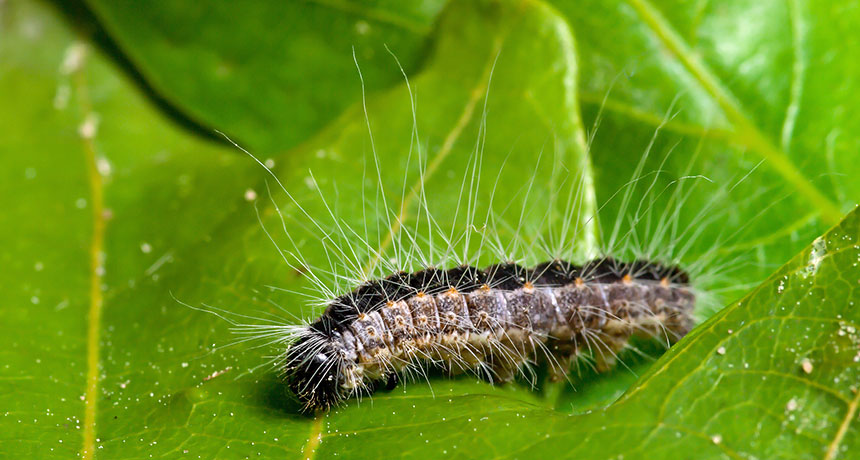These caterpillars are scaring the city of London
Crawling, fluffy oak processionary moth larvae pose threats to trees and human health

European oak processionary caterpillars (one shown) have a scary hair problem. It’s not the long hairs you need to worry about, but the near-invisible short ones.
CHRISTIAN FISCHER/WIKICOMMONS (CC BY-SA 3.0)
By Susan Milius and Aimee Cunningham
Insect control in spring can get surreal in London, England, these days. Consider the guy wearing a full-body protective suit with face mask and goggles. He’s about to do battle with the young of oak processionary moths. Adults are harmless and not much to look. But the caterpillars are truly irritating. And that explains the body suits donned by moth-control crews.
England’s battle against these oak leaf–stripping caterpillars gripped the news earlier this year. It had been triggered by the year’s new generation of caterpillars. The trouble starts right after they finish their second molt.
These larvae sport short barbed hairs that can prick any fool — or curious puppy — who pokes them. A protein on those hairs can provoke an irritating rash. But these caterpillars can bring suffering even to people who’d never torment the larvae — or touch one. How? Stray hairs lost by caterpillars can waft through the air on spring breezes — landing on skin and, potentially, in the eyes or throat.

Native to southern Europe, this species (Thaumetopea processionea) likely came to England as eggs on live oak trees in 2005. That’s the best guess, anyway, of the U.K. forestry commission.
The name processionary comes from the caterpillars lining up head-to-rump. “A column of caterpillars moving together like a train,” is how Jim Costa describes it. He’s an evolutionary biologist at Western Carolina University in Cullowhee, N.C. A little rearrangement can get processions trudging round and round in a circle.
The caterpillars aren’t much for housecleaning. A group of them will spin a baggy silk nest high in any of several types of oak trees. That nest accumulates cast-off skins still hairy with the toxic protein.
Other nations have irritating processions of their own, notes Terrence Fitzgerald. He’s an entomologist, or insect specialist. He works at the State University of New York at Cortland. One cousin of the London invader is the pine processionary moth (T. pityocampa). It may be edging northward in Europe as the climate there warms. In the United States, dark and prickly caterpillars of the buck moth (Hemileuca maia) show up at various places in the East. They are a traditional spring irritant, for instance, in New Orleans, La.
Annoyances aside, these creatures represent part of the glorious but less-appreciated communities of social insects, Fitzgerald says. Ants, bees, wasps and termites have long been known as the social insects. But building joint nests and traveling in caravans are just some of these caterpillars’ coordinated projects. If fish or birds did that, he grumbles, they’d be acclaimed as “fabulous animals.”
Why touching these caterpillars is a bad idea
The caterpillars can sport as many as 630,000 setae. These hairlike structures are just 100 to 500 micrometers (4 to 20 thousandths of an inch) long. They can detach. Afterward, they can land on skin, in soil, on clothes and wherever else the breeze make take them. What’s more, they retain their power to irritate long after the caterpillars are gone.
Andrea Battisti is an entomologist at the University of Padova in Italy. He has been studying processionary caterpillars for nearly four decades. He knows well the very early symptoms of exposure. These are burning eyes, the beginning of a skin rash, an itchy feeling, swelling — just a general irritation. Scratching “is difficult to resist,” he says. To avoid spreading the misery to other parts of the body, one must first undress carefully, he says. Then the contaminated clothes have to be put through a long, hot wash. And the person must shower without touching any affected areas.
A protein in the setae may be responsible for the bad reactions. It’s called thaumetopoein. (A structural protein in the setae — chitin (KY-tin) — also may trigger inflammation and an immune response.) Touching the caterpillars or their nests isn’t even necessary for a reaction. Inhaling setae can cause wheezing and shortness of breath. Getting them in the eyes can lead to conjunctivitis (Kon-JUNK-tih-VY-tis). (That’s an inflammation of the lining of the inner eyelid and white parts of the eye.) A caterpillar encounter may also lead to fever, dizziness and vomiting.
It may take days for the reactions to develop after the first exposure. Symptoms will tend to occur more quickly the next time around.
There have been a few case studies looking at exposures to processionary caterpillars. Those studies suggest that everyone may not suffer.
In Spain, 70 schoolchildren on an outing near pine trees with nests of pine processionary caterpillars. The caterpillars had been crawling near a pool in which the kids swam. Six children reported skin inflammation needing medical care. They had dried themselves with towels that had come in contact with the critters.
There was also study of some residents living just outside Vienna, Austria. They all lived within 500 meters (1,600 feet) of oak trees infested with oak processionary caterpillars. Of 1,025 surveyed, only 57 reported symptoms. Mostly, they complained of itchiness or patches of inflamed skin.







